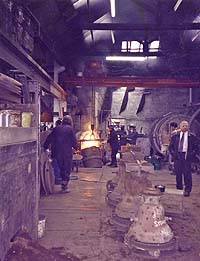The Wotton Quarterly Magazine of 1902 carried correspondence on the inscriptions on the church bells of Wotton and Abinger. The original Abinger bells were probably cast in the mid 14th century, and were mentioned in the inventory of 1553 as “Item, iij belles in the steple, the best by estymacion, viii and the resydew under after the rate”. These were recast in 1674 (“William Eldridge made mee, 1674”). The ‘viij’ means 8 cwt.
The bells were recast at the time of the first of the Victorian restorations’ by Mears and Stainbank, Founders, London, 1880 and one was Inscribed “H.S. & D. D. Churchwardens ” (Henry Spooner and Daniel Dibble). It is customary for bells and similar objects to carry the names of the Churchwardens (but not the Rector!) – Terence O’Kelly – letter to Abinger & Coldharbour Parish News, February 1998.
To celebrate the 2000 millenium, 3 new bells were commissioned by St James’.
Photographs of a visit to Whitechapel Bell Foundry Ltd in March 1999 to see St James’ three new bells being cast. The ancient craft of bell founding has been carried out by the London firm since its origins in the East End in 1420.
Other bells cast that day were for Sydney, Australia; Wye, Kent; and Beoley, Worcestershire.

“We are fortunate in the loyalty of our customers,” Mr Hughes of the Whitechapel Bell Foundry mused. “Westminster Abbey’s bells have been looked after by us since 1583, though recently we found that a church in Wimbledon had been dealing with our firm” – he paused with a raconteur’s sense of timing – “since 1520!” Mr Hughes is the senior member of a dynasty of bellfounders, the head of a firm whose origins reach back to 1420. Twisting Bilitier Street, close to the foundry’s premises in London’s East End, confirms the long association between Whitechapel and bellfounding – the name is Norman French for a maker of bells. Originally, church bells were cast on-site, especially those to be installed in the great cathedrals. Soon, however, permanent foundries came into being and by 1420 Robert Chamberlain, the first of the Whitechapel’s master founders, was established in the East End. Some of the bells cast by Chamberlain are still in use today. Given such durable and long-lasting products perhaps it is not surprising that only two foundries for casting bells remain in the United Kingdom, one in Loughborough and the other in Whitechapel.
Another notable master founder devised the Whitechapel’s distinctive stamp in 1574 and Robert Mot’s initials are still carried on it. Church bells were at first used as conveyors of messages: their peals calling the faithful to worship, ringing out times for special prayers, warning of approaching danger (a custom continued in the last war, when church bells were to be rung should the country be invaded). During the 18th century, however, a new practice arose: bells were used to make music. The practice of change-ringing began in Cambridge, spread rapidly to London and now has devotees all over the world. In change-ringing, bands of ringers weave complex patterns of sound and rhythm from bells which swing fill-circle, each under the control of one ringer. The tone of the bell became increasingly important as harmony took precedence over mere clamour. The immense popularity of change-ringing brought prosperity to the Whitechapel Foundry.
The great clock-bell for St Paul’s was cast in 1716 and is still in use. Bow Bells were cast between 1738 and 1762, a peal of change-ringing bells for Christchurch Philadelphia in the same Year (the first of many transatlantic bells to be made by the company), and a set of bells for St Petersburgh was cast in 1747. The brittle quality of the bell-metal makes the correct hanging of the bell of first importance. From the 19th century onward a Whitechapel bell would be accompanied by a member of the firm who would ensure its correct installation. The 19th century bells (like 19th century belles perhaps?) were a little on the heavy side. Great Tom of Lincoln weighed 5 1/2 tons; Great Peter of York Minster weighed 10 1/2 tons; a bourdon (bass) bell for Montreal was 11 1/2 tons. But Big Ben led the field at 13 1/2 tons; today the foundry doorway is set with an outline of this world-famous bell. Many London churches lost their bells during wartime and replacements for them have been made in Whitechapel: a second set of Bow Bells, for example, and the St Clement Dane’s ring immortalized in “Oranges and Lemons”. A Bicentennial Bell was cast in 1976 as a gift from Britain to the United States and a flourishing trade still continues abroad. Should you chance to visit York Minster, the famous Bellfounder’s Window in the North Aisle gives a vivid description of the process of casting bells.
The craft has hardly changed over the last six centuries. A bell is cast over a core of specially made heat-conducting bricks overlaid with loam and smoothed into shape using a “strickle”. A metal cope is similarly lined and any inscription required is added. Then the cope is fitted over the core and the molten poured into the bell-shaped cavity. The whole is left to cool for several days, after which the bell is polished and tuned.
Change-ringers are very nice in their tastes; a single bell has no less than five separate tones which must be tuned harmonically before the bell is tuned to blend with its companions. A battery of electronic devices facilitates this tricky process. In addition to large bells the Whitechapel foundry also makes the oldest form of bell known – the handbell, which is also cast into sand moulds. The Whitechapel turns out sets of tuned handbells (some sets number as many as 200) which are marketed worldwide.
From Abinger & Coldharbour Parish News, April 1999.
Abinger Common, Surrey RH5 6HZ ///delay.trials.plans
Tel: 01306 737160


Data Protection & Privacy
We do not track any browsing activity on this website.
We may sometimes link to external sites and social media but are not responsible for the content of these websites and you should refer to their individual privacy and cookies policies.
If you are included in an event photo and do not wish to be please contact us and we will remove – Contact Us

If you would like to apply for a Login account to help update this site, please email the web team here.